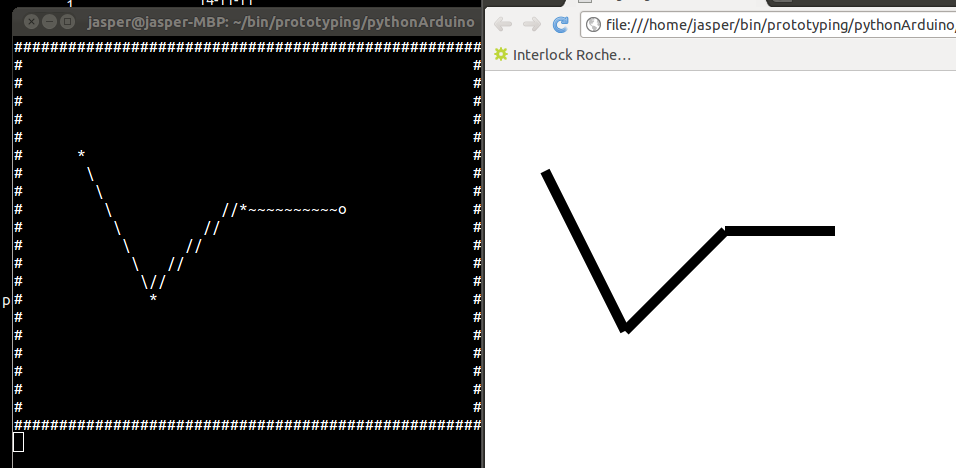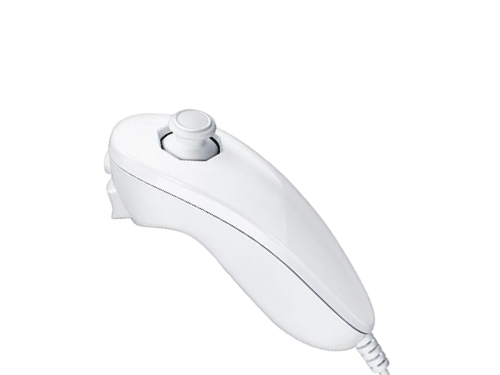Reading Wii Nunchuck data in Python: Difference between revisions
No edit summary |
No edit summary |
||
| Line 1: | Line 1: | ||
[[Category: Cookbook]] | |||
'''Brief description:''' | '''Brief description:''' | ||
Use the Wii Nunchuck to draw in the terminal and turn the drawing into a SVG | Use the Wii Nunchuck to draw in the terminal and turn the drawing into a SVG | ||
Revision as of 16:15, 1 December 2011
Brief description:
Use the Wii Nunchuck to draw in the terminal and turn the drawing into a SVG
Since I installed Linux I use the terminal a lot. I really like how you can use something text based and really basic to perform all kinds of complex tasks.
After messing with SVG for a bit I thought it might be interesting to use the text based terminal as the interface to a SVG generating script. Also, I wanted to see how I could use the terminal together with an Arduino, so I used one to connect my Python script too a Wii controller (Nunchuck), which is used as input for the script.
The Nunchuck's joystick controls the cursor, the Z (large) button lets jou draw lines (press and hold while moving around) and the c button creates and shows the SVG. Using the WiiChuck class the arduino reads the data which is then send to Python though a serial connection. To connect the Nunchuck to the Arduino without cutting the cable I used the Wiichuck adapter. Both the class and the adapter are available here.
[Disclaimer] Since I wrote the code from scratch and added 'features' as I went along I bet it's far from optimized. But it seems to do the job.
Python code
#=========================================================
# Import libs and set basic vars
#=========================================================
import serial, os, math
width, height = 50, 20
xpos, ypos = 0, 0
sx, sy = -1, -1
zbut, prevZbut, cbut = 0, 0, 0
cursorChar, prevCursorChar = "o", ""
svgScale = 10.0
svgHeightCorrection = 2
theScreen = [] #will hold all of the 'pixels'
fullRow = "" # the line of #s for use at the top and bottom
for x in range(0, width+2):
fullRow += "#"
#initiate the screen arrays
for y in range(0, height):
xlist = []
for x in range(0, width):
xlist.append(" ")
theScreen.append(xlist)
svgOut = ""
#=========================================================
# function to draw the arrays to the screen
#=========================================================
def display():
global theScreen
global cursorChar
global xpos
global ypos
prevCursorChar = theScreen[ypos][xpos]
theScreen[ypos][xpos] = cursorChar
os.system("clear")
print fullRow
for y in theScreen:
printLine = "#"
for x in y:
printLine += str(x)
print printLine+"#"
print fullRow
theScreen[ypos][xpos] = prevCursorChar
#=========================================================
# function to draw a line
#=========================================================
def drawLine(x1, y1, x2, y2, useInSvg):
global theScreen
global svgOut
global svgScale
global svgHeightCorrection
bx1, by1, bx2, by2 = int(x1), int(y1), int(x2), int(y2)
x1 = max(0, min(x1, width))
x2 = max(0, min(x2, width))
y1 = max(0, min(y1, height))
y2 = max(0, min(y2, height))
d = math.atan2(y2-y1, x2 - x1)*180/math.pi #d = direction
d2 = d
if d2 < 0:
d2 = (360-abs(d2))
dist = math.floor(math.sqrt((x1-x2)*(x1-x2) + (y1-y2)*(y1-y2)))
lineChar = "*"
if (d2 >= 360-22.53 or d2 < 22.5) or (d2>=157.5 and d2<202.5):
lineChar = "~"
elif (d2 >= 22.5 and d2 < 67.5) or (d2>=202.5 and d2<247.5):
lineChar = "\\"
elif (d2>=67.5 and d2<112.5) or (d2>=247.5 and d2<292.5):
lineChar = "|"
elif (d2>=112.5 and d2<157.5) or (d2>=292.5 and d2<337.5):
lineChar = "/"
step = 0
while(step < dist):
x1 += math.cos(d*math.pi/180)
y1 += math.sin(d*math.pi/180)
if x1>width:
x1 = width-1
x2 = width-1
elif x1<0:
x1 = 0
x2 = 0
if y1>height:
y1 = height-1
y2 = height-1
elif y2<0:
y1 = 0
y2 = 0
drawY = int(math.floor(y1))
drawX = int(math.floor(x1))
if drawY < len(theScreen):
if drawX < len(theScreen[drawY]):
theScreen[drawY][drawX] = lineChar
step = step + 1
theScreen[by1][bx1], theScreen[by2][bx2] = "*", "*"
if useInSvg==1:
svgOut = svgOut + """<line x1="{0}" y1="{1}" x2="{2}" y2="{3}"
style="stroke:rgb(0,0,0);stroke-width:{4}"/>""".format(bx1*svgScale, by1*(svgScale*svgHeightCorrection), bx2*svgScale, by2*(svgScale*svgHeightCorrection), svgScale)
def drawEllipse(x, y):
global svgOut
print "at: "+str(x)+", "+str(y)
svgOut = svgOut + """<ellipse cx="{0}" cy="{1}" rx="{2}" ry="{2}"
style="fill:black;"/>""".format(float(x)*2*svgScale, float(y)*svgScale, svgScale/2)
#=========================================================
# Save image, open and quit
#=========================================================
def saveOpenAndQuit():
global svgOut
global width
global height
global svgScale
svgOut = """<svg xmlns="http://www.w3.org/2000/svg" version="1.1" width="{0}" height="{1}">""".format(svgScale*width, svgScale*(height*svgHeightCorrection)) + svgOut
svgOut = svgOut + "</svg>"
fo = open("image.svg", "wb")
fo.write( svgOut);
fo.close()
os.system("google-chrome image.svg &")
#=========================================================
# Main loop
#=========================================================
loop = 0
ser = serial.Serial('/dev/ttyACM0', 19200)
while 1:
loop = loop + 1
serialData = ser.readline()
serialData = serialData.replace("\r\n", "")
dataList = serialData.split(',')
if len(dataList)==6:
prevZbut = zbut
accx = float(dataList[0])
accy = float(dataList[1])
zbut = float(dataList[2])
cbut = float(dataList[3])
joyx = float(dataList[4])
joyy = float(dataList[5])
#move cursor around
if joyx>150:
xpos = xpos + 1
elif joyx<100:
xpos = xpos - 1
if joyy>150:
ypos = ypos - 1
elif joyy<100:
ypos = ypos + 1
xpos = max(0, min(xpos, width-1))
ypos = max(0, min(ypos, height-1))
#remember previous char on cursor location
prevCursorChar = theScreen[ypos][xpos]
if cbut==1:
saveOpenAndQuit()
cursorChar = "o"
if zbut==1 and prevZbut==0:#click, starting to draw
sx, sy = xpos, ypos
theScreen[ypos][xpos] = "*"
cursorChar = "x"
display()
elif zbut==1 and prevZbut==1:#dragging around
cursorChar = "*"
#somehow I need to iterate over the tempScreen and theScreen arrays
#instead of just copying them with .extend
tempScreen = []
for y in range(0, height):
xlist = []
for x in range(0, width):
xlist.append(theScreen[y][x])
tempScreen.append(xlist)
drawLine(sx, sy, xpos, ypos, 0)
display()
theScreen = []
for y in range(0, height):
xlist = []
for x in range(0, width):
xlist.append(tempScreen[y][x])
theScreen.append(xlist)
elif zbut==0 and prevZbut==1:#released
theScreen[ypos][xpos] = "*"
cursorChar = "x"
if sx==xpos and sy==ypos:
drawEllipse(xpos, ypos)
else:
drawLine(sx, sy, xpos, ypos, 1)
sx, sy = -1, -1
display()
elif zbut==0 and prevZbut==0:#doing nuthin'
cursorChar = "o"
display()
Arduino code
#include <Wire.h>
#include "nunchuck_funcs.h"
int loop_cnt=0;
byte accx,accy,zbut,cbut,joyx,joyy;
int ledPin = 13;
void setup()
{
Serial.begin(19200);
nunchuck_setpowerpins();
nunchuck_init(); // send the initilization handshake
}
void loop()
{
if( loop_cnt > 100 ) { // every 100 msecs get new data
loop_cnt = 0;
nunchuck_get_data();
//nunchuck_print_data();
accx = nunchuck_accelx(); // ranges from approx 70 - 182
accy = nunchuck_accely(); // ranges from approx 65 - 173
zbut = nunchuck_zbutton();
cbut = nunchuck_cbutton();
joyx = nunchuck_joyx();
joyy = nunchuck_joyy();
Serial.print((byte)accx,DEC);
Serial.print(",");
Serial.print((byte)accy,DEC);
Serial.print(",");
Serial.print((byte)zbut,DEC);
Serial.print(",");
Serial.print((byte)cbut,DEC);
Serial.print(",");
Serial.print((byte)joyx,DEC);
Serial.print(",");
Serial.print((byte)joyy,DEC);
Serial.println();
}
loop_cnt++;
delay(1);
}


